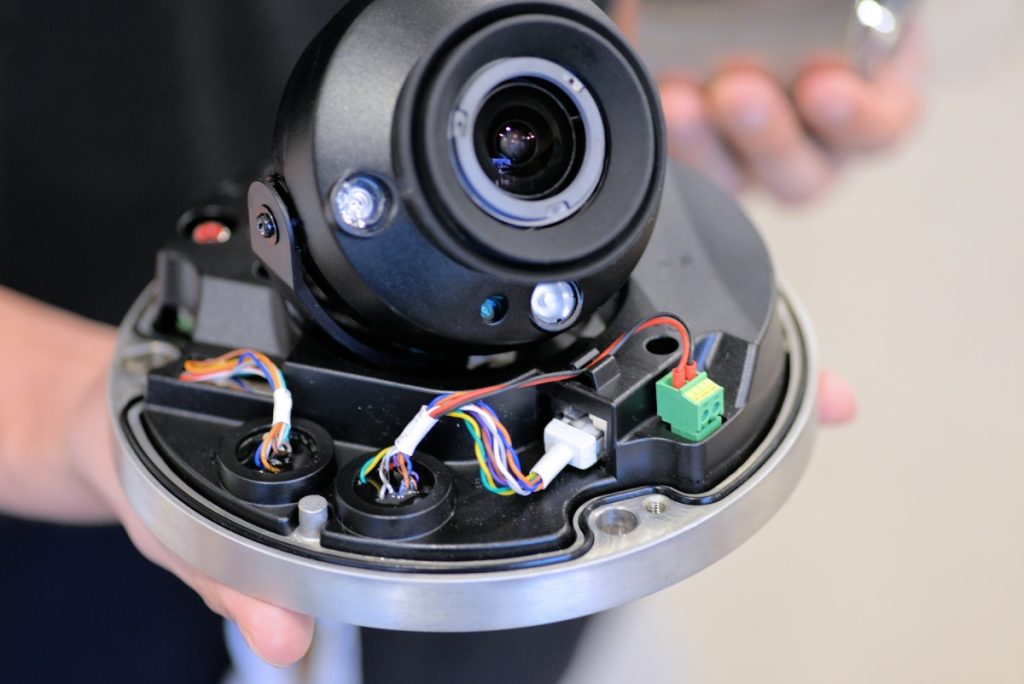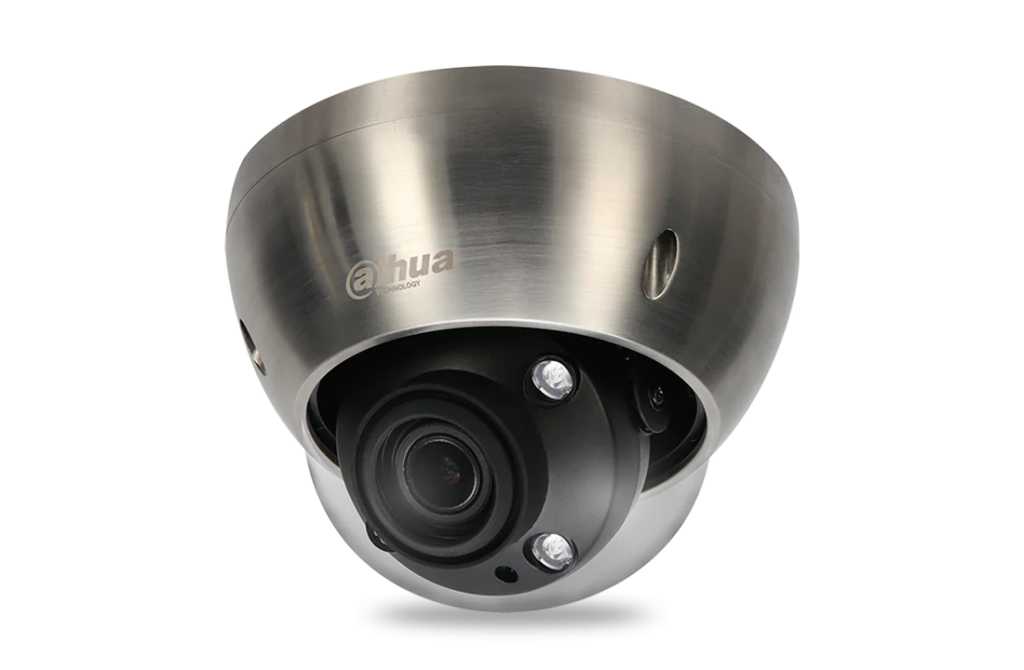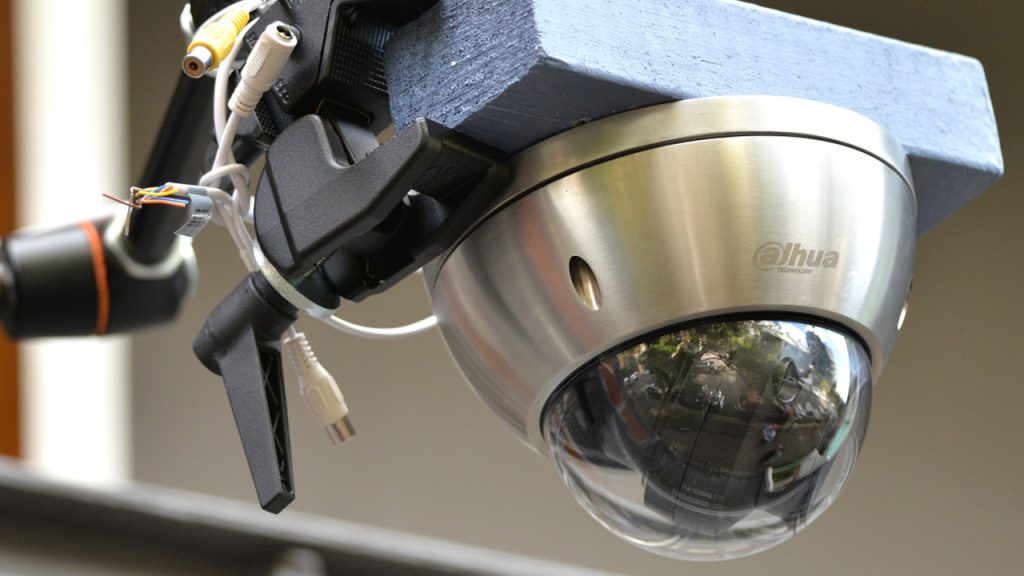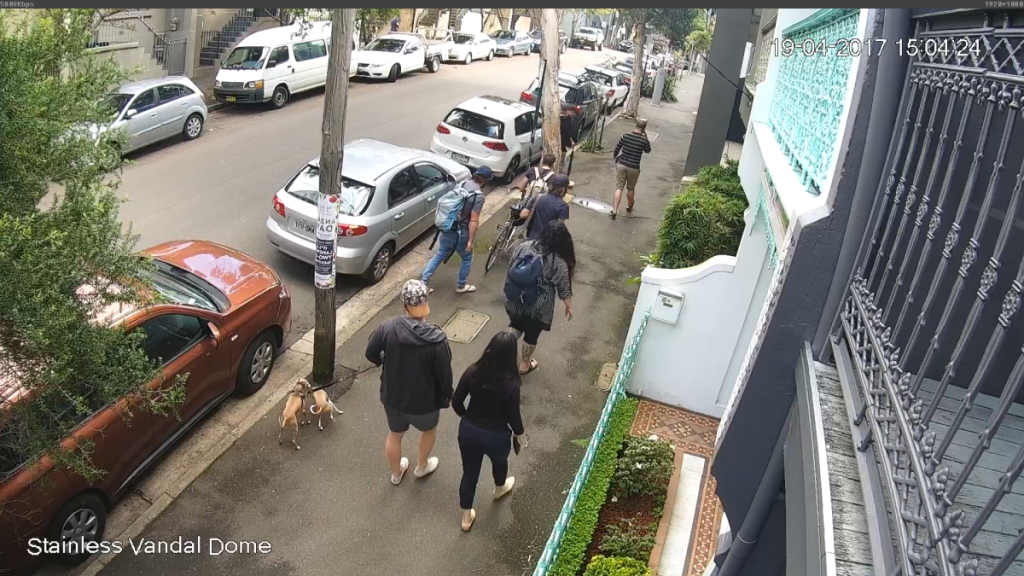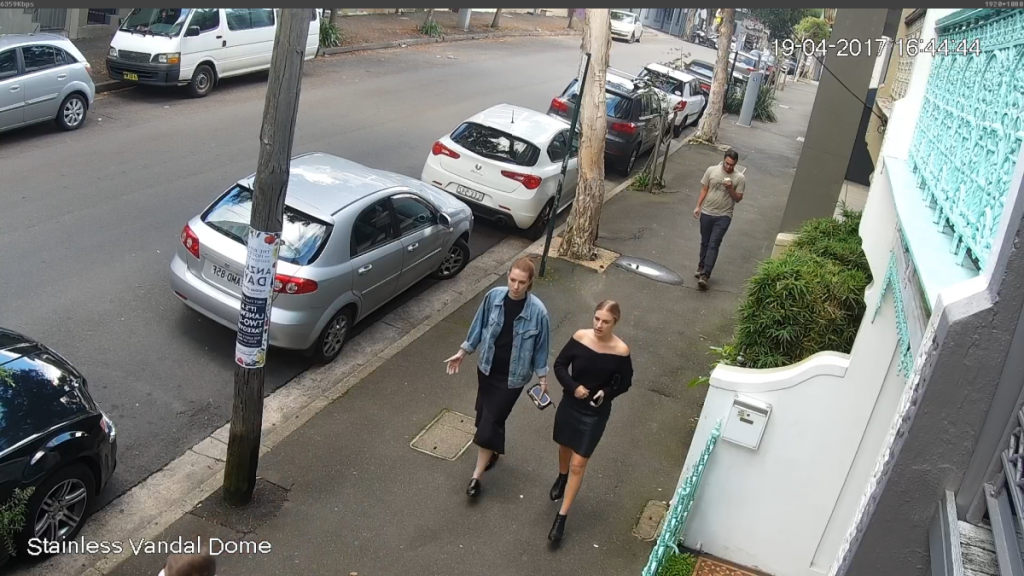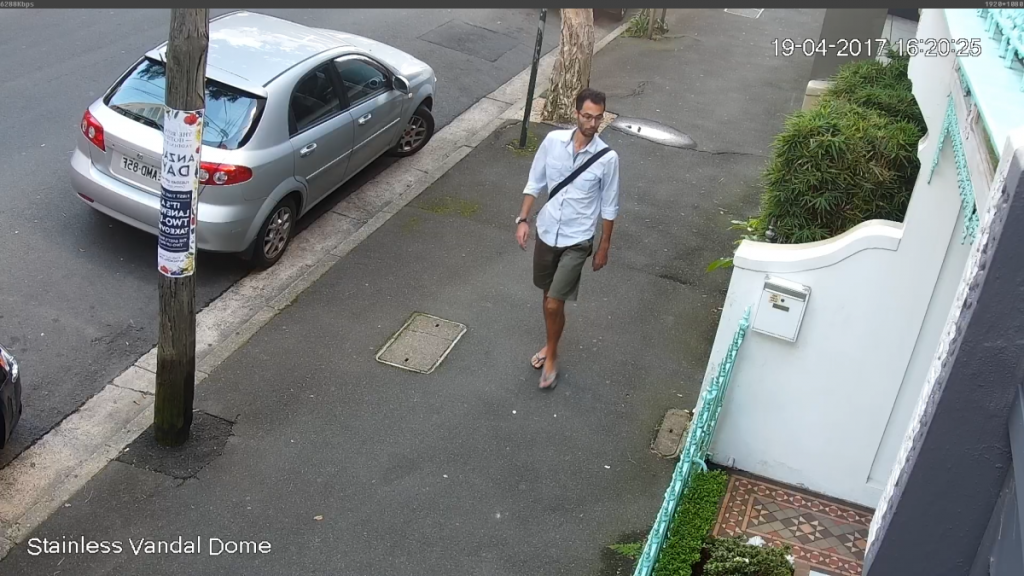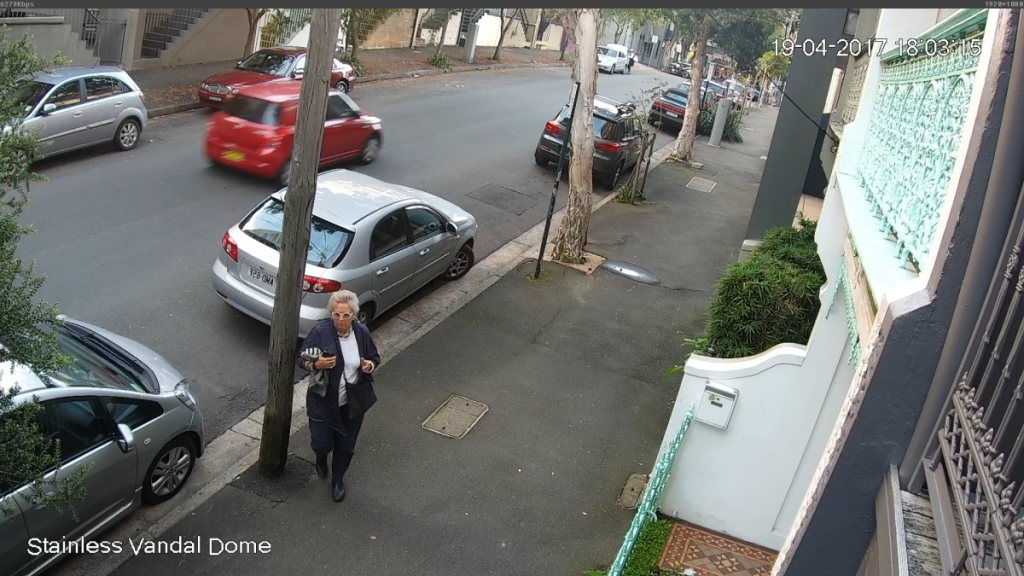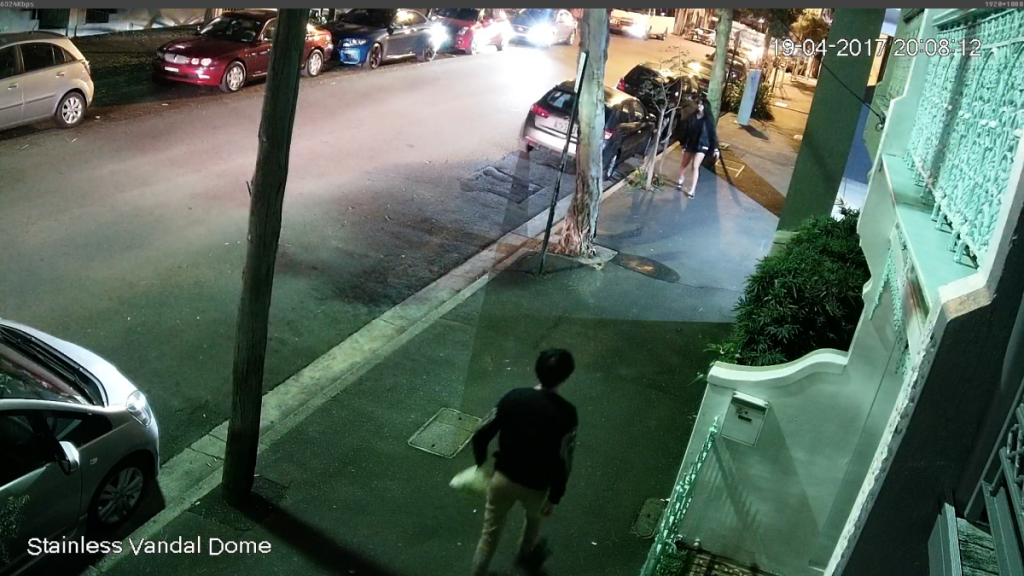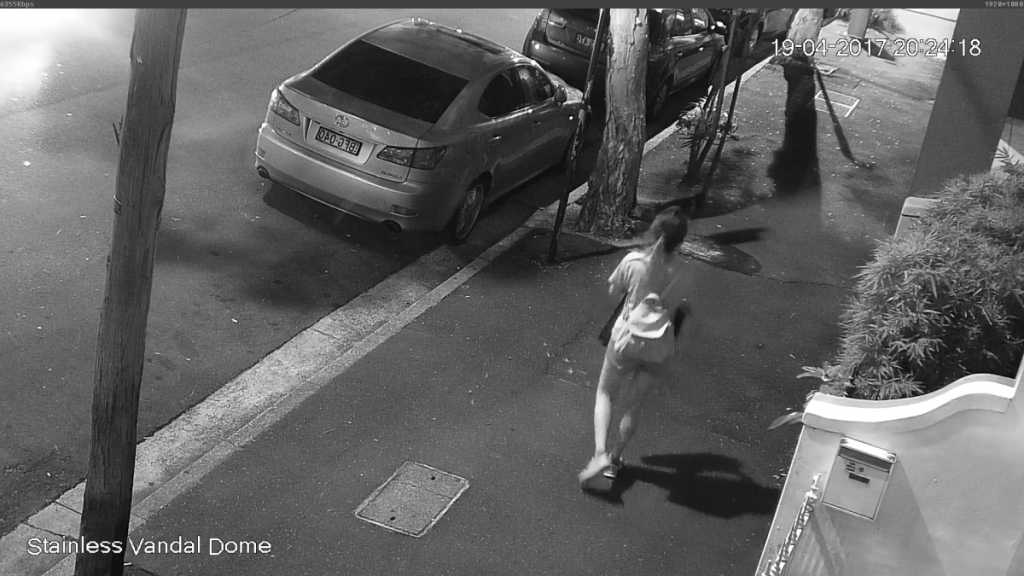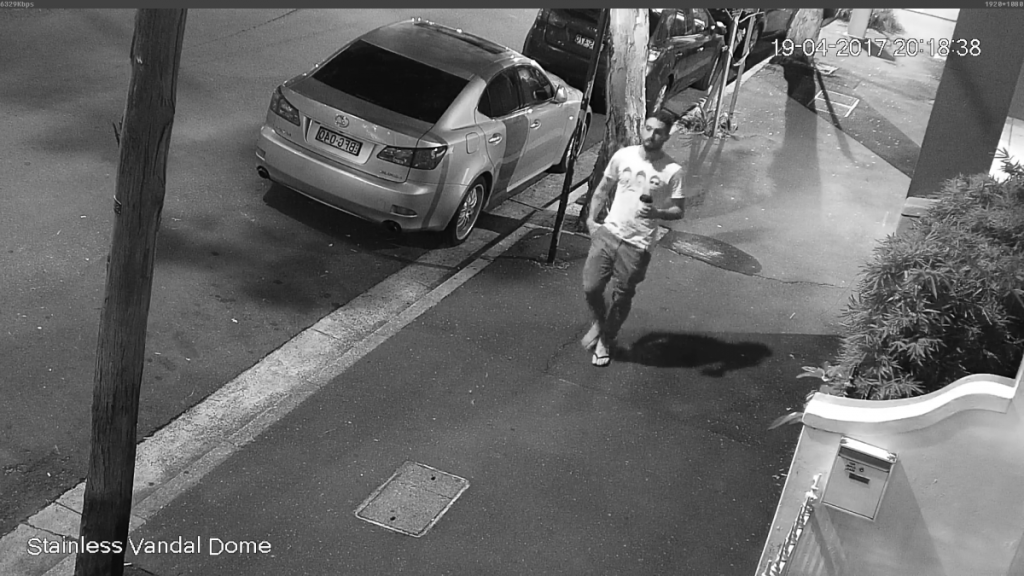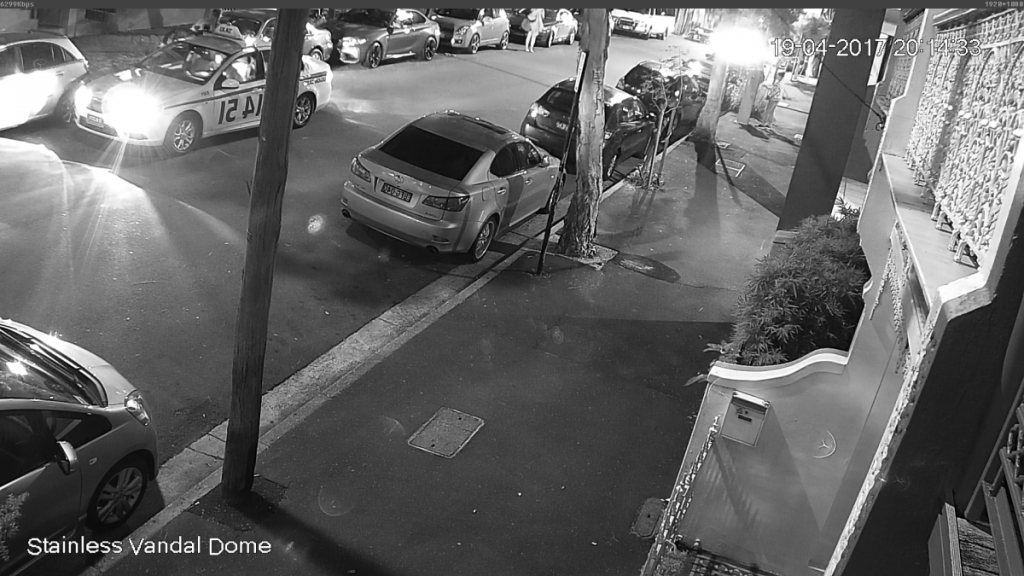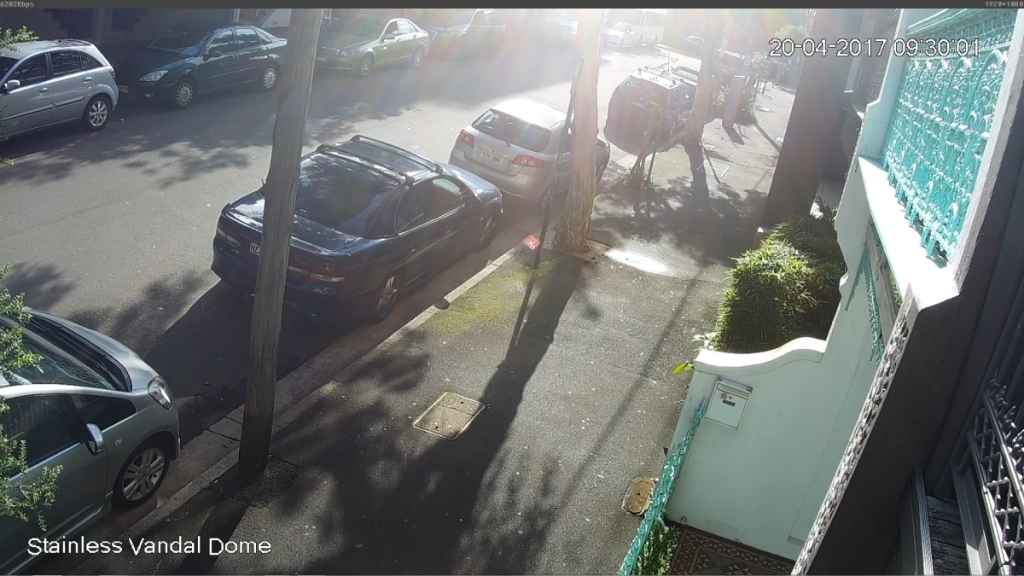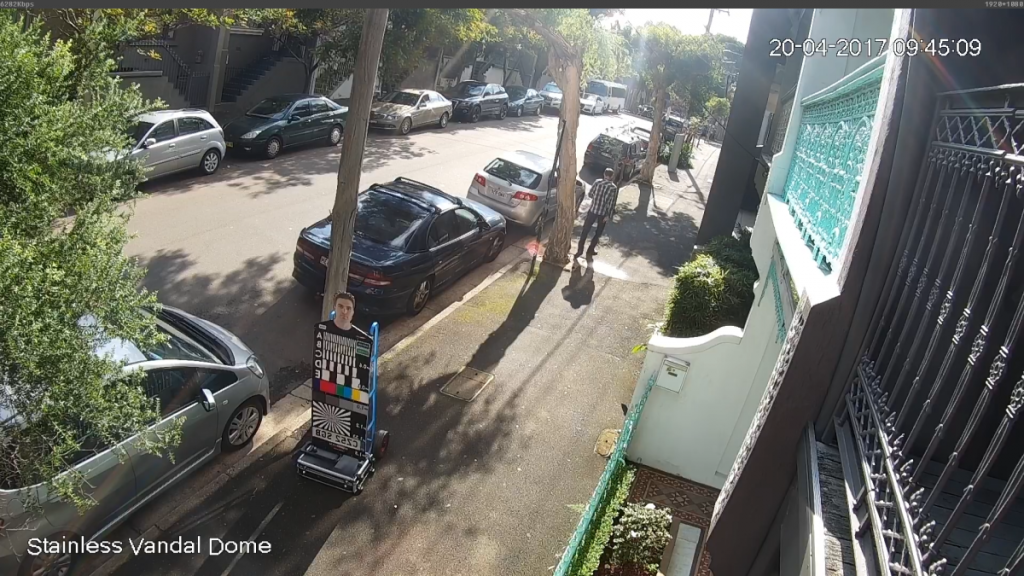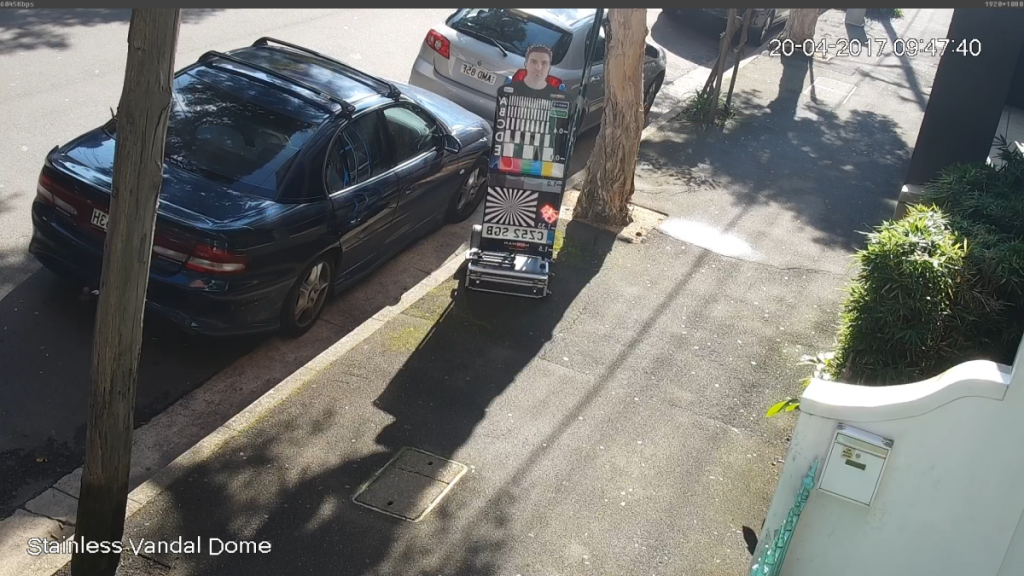Dahua’s IPC HDBW8232E-Z-SL is a 2MP, Starlight, anti-corrosion dome featuring a 1/1.9-inch 2MP progressive-scan CMOS sensor, 120dB of WDR capability, delivering 60ips at 1080p, a 4.1-16.4 mm motorised lens, 50m of IR, IP67 and IK10 rating and H.264 and H.265 compression options.
Performance matches the feature set.
Contents
This updated review features the IPC HDBW8232E-Z-SL showing the solid quality and difficult to beat excellent performance of this series of cameras.
Introduction
The Dahua Starlight IPC HDBW8232E-Z-SL is hewn from a lump of 316L stainless steel, and the immediate impression you get when you hold the camera in your hands is its build quality. It’s tough, the finish is excellent, there’s potting of terminations in the camera chassis, rubber weather seals, polishing of metal and the bubble appears to be largely untainted.
Best of all, sensor performance closely matches the exceptional specification. Dahua’s 2MP Starlight cameras are strong performers, but this new release seems to be the best we’ve ever tested. The camera has a 4.1-16.4 mm motorised lens with a magnesium-fluoride coating (550 nm) and a maximum aperture of F1.53 – in short, it’s a fine lens. But before we get into our testing, let’s run through some camera specifications.
Best of all, sensor performance closely matches the exceptional specification.
John Adams
Design
At the heart of this camera is the 2MP 1/1.9-inch progressive scan CMOS sensor, delivering 1080p at 60ips and 120dB of WDR. Minimum scene illumination is claimed to be 0.002 lux in colour at 1/3rd of a second and 0.01 lux at 1/30th of a second. Frankly, 1/3rd of a second shutter speeds are more creative than useful with moving objects – you will get significant motion blur. However, in static scenes you’ll get good detail, including plates – and you may get static faces, especially if there’s extra light thrown onto them by mobile device use.
Signal-to-noise ratio is greater than 50dB, the IR range is up to 50m, the angle of view is 92 degrees at the wide end and 32 degrees at the long end, the camera chassis has up to 355 degrees of rotation. There’s a microSD card slot and you interface with the camera through web viewer (I start with CMS DSS then use web viewer), CMS(DSS/PSS) and/or DMSS. When it comes to intelligent video analysis, the camera offers tripwire, intrusion, object abandoned/missing and there are advanced intelligent functions including face detection, people counting and heat map.
Video compression options include H.265+/H.265/H.264+/H.264 in 3 streams and audio compression (in/out) is G.711a/G.711Mu/AAC/ G.726. There’s bit rate control via CBR/VBR, BLC, white balance options including; auto, natural, street lamp, outdoor and manual.
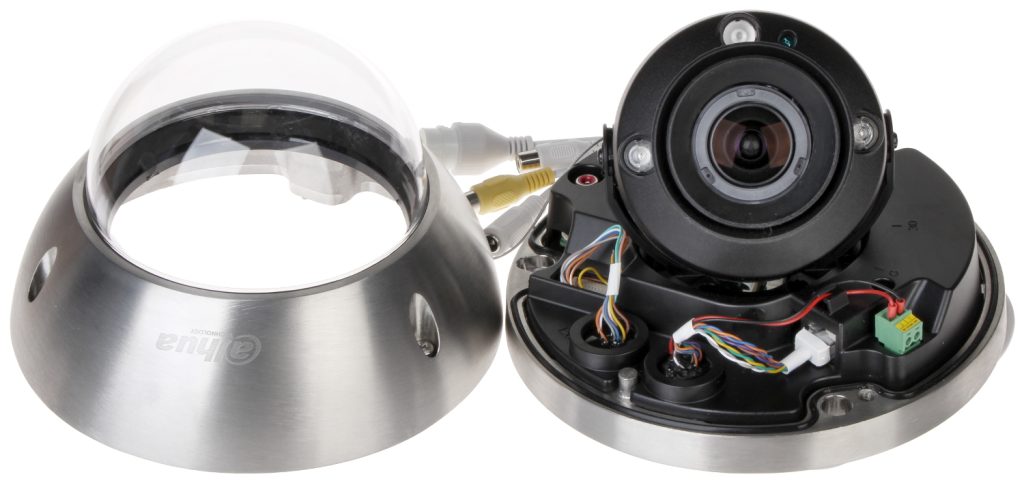
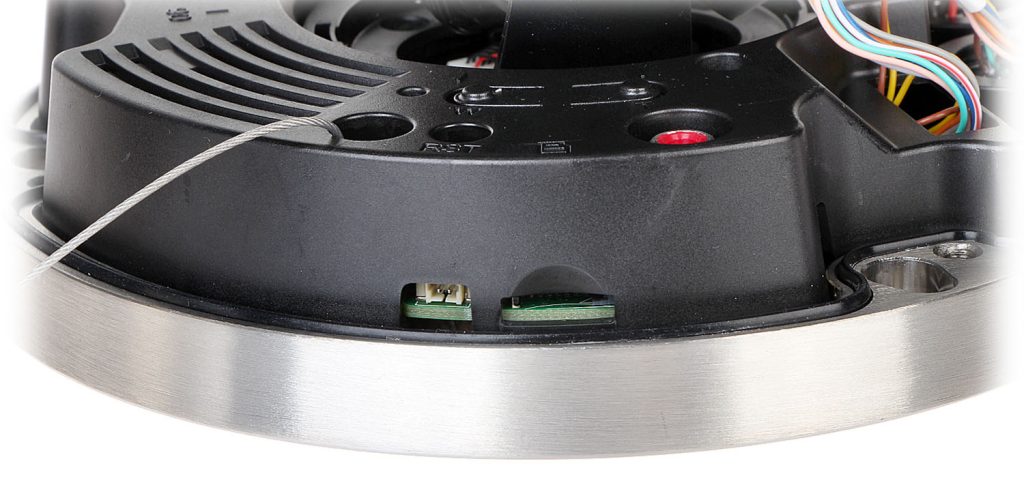
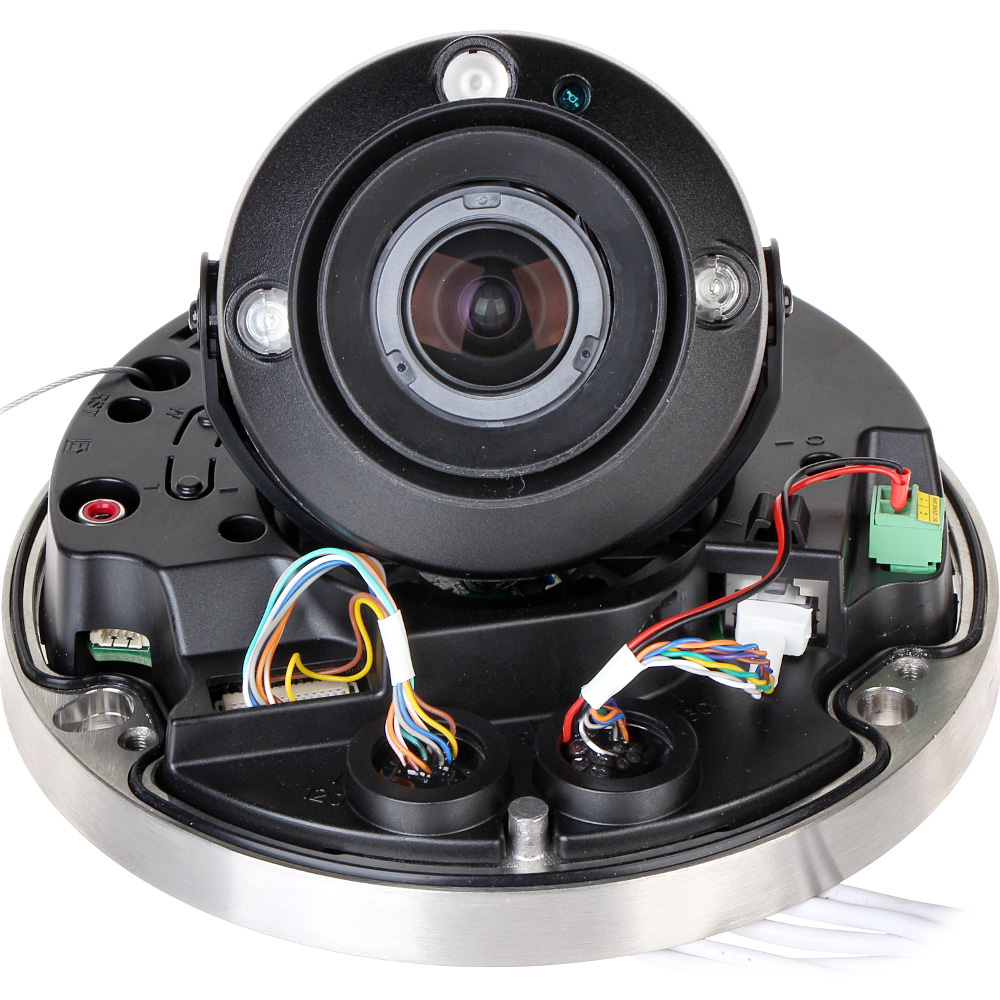
Dahua Starlight Also Offers:
- Auto and manual gain control
- Auto and manual noise reduction
- 3D DNR, motion detection options including off/on in 4 rectangular zones
- Region of interest and privacy masking, both in 4 rectangular zones
- Electronic images stabilisation
- Defog
- 16x digital zoom
- Flip options including 0, 90, 180 and 270 degrees
I’m using 180 degrees for this test.
Other features include a full range of network security features, an alarm input, ONVIF, PSIA, CGI compatibility and IOS and Android support. Power consumption is less than 18W, operating temp is -40 to 60C. The dimensions are 162.3 mm x 118.1 mm and the weight is 3 kg. As mentioned, this PoE camera is a tough monkey, rated to IP67 and IK10.
As mentioned, this PoE camera is a tough monkey, rated to IP67 and IK10.
Driving the Dahua Starlight HDBW8232E-Z-SL
We’re conducting the test on SEN’s Dell OptiPlex 9020, which features an i7 processor with 8 GB of RAM. While this is not a particularly high-spec server on the GPU side, the Dahua Starlight handles perfectly well with it, suggesting a relatively lightweight processing demand at 2MP and 60ips. As usual, we’re powering the camera through a basic Netgear ProSafe GS108P switch.
There’s nothing else running on the server or the network to cause latency or hassles. Setup is easy, once I get my IP address range properly matched. Bear in mind in the late afternoon and evening shots, the clock on the image display is set to daylight saving time – it’s an hour ahead.
It’s afternoon when I start the test and the day is a little murky, but I get a good sense of camera performance as soon as I hang this camera on the balcony and sit down at the workstation. This big sensor drags in a lot of detail – the reflections in the paintwork of cars on the street, details of trees and pedestrians. Something else I notice immediately is the depth of field at wider angles of view – I’m at around 5.5 mm a lot of the time in this test, and the depth of field is high quality.
I put it down to lens sharpness, sensor quality and the evolution of Dahua Starlight’s WDR processing algorithms. Distortion is around 6 per cent at the wide end – it’s gone by 5.5 mm. I don’t see any chromatic aberrations at all, which is a big deal because it suggests Dahua is paying serious attention to lens quality in-house. Seemingly small things like this speak of a culture of quality manufacture. I keep an eye on the bitrate throughout the test – it’s around, 6200kbps most of the time, even with a lot of movement in the scene.
Motorisation
When you’ve got a motorised zoom lens, it’s hard not to use it. Lens performance in terms of zoom and autofocus is superb. After using the zoom slider, re-focus is only about a second behind – that’s great for live work.
The 4x motorised zoom is ideal for a fixed PTZ like this, but you need to take care with mounting height and primary angle of view. It is relatively easy to zoom too far with a fixed zoom camera, especially if it’s looking downwards.
I wind up tilting the camera back on its haunches in the magic arm to lift the horizon. You can do this by tweaking the camera body inside the housing, too, but I take the easy out today.
My settings are generally default with everything on auto. I notice there is some over exposure on the sunny side of the street my default settings can’t manage, but the balance between bright and dark is handled very well.
Over exposure reduces detail. When the sun moves away a little, the depth of field really opens up – I’m talking between 40 and 80m at the wide end of the lens. I can’t get plates of fast-moving cars at the wide end as the afternoon darkens. Unlike many low ends 1080p cameras, digital zoom well worthwhile – I get value out of 6 or 7 rolls of the mouse wheel – 16x takes me to pixellation but at more realistic levels, it’s excellent performance.
Colourisation and Low Light
Faces stay with me as the lights falls – sometimes they don’t – and this is very pleasing. You get court admissible faces out past 12m with this camera at 4.1 mm – within this distance, faces are guaranteed. This is all down to image quality from the lens and camera system. The large sensor means greater pixel spread at 4.1 mm, remember. Going through the images later, I think I’m getting distinguishing facial features at 20m with the lens set wide – that’s very good.
When I go to the long end with the lens, sharpness improves, though I lose my depth of field thanks to the camera angle. At the long end, even in failing light and with reduced aperture, faces are brilliant. When I return to wide, a truck goes and again no plate, but everything else is clear – no tone mapping, no rocket tail of mid-processed pixels – it’s a rock-solid image. At about 5pm I start getting some blur with fast-moving cars as the shutter slows down and this impacts on faces and moving legs, too. Walking pedestrians are still great, but when a woman runs down the street, no face recognition.
With the Dahua Starlight camera locked in colour and colour rendition, which was solid all afternoon, hangs together at 7 lux in low-pressure sodium streetlights. Under the low-pressure lights, colours tend to yellow orange, but the next light up seems to be LED, and the colours are very true without false colour. At one point out here, a car headlight catches the camera and there’s noticeable blooming, but control of blooming is, generally, excellent.
The overall ability to hold colour in very dark conditions is exceptional – there’s a price in the slow-ish shutter speed, but the low light ability is exceptional. It stays solid with pedestrians and face recognition is readily available in colour in sub 10 lux out to 10m – further if there’s some environmental light of the type I have in this scene. Skin tones are strong, too.
Moving cars are harder to manage – there’s a point in the afternoon when you can no longer secure plates and later blur increases, but it never seems out of control. Something that’s good is the lack of tone mapping around moving objects until things are quite dark. Control of blooming is exceptional as light falls. There are 4-pointed aperture stars. Static plates are great, too. Depth of field stays good into the night, as does detail. For a 1080p camera, detail is very high indeed at wider angles of view. This is a fine camera for the many applications that are heavy on foot traffic at night.
Next, I check out monochrome performance and hopping into the browser, I lock the camera into night mode. Again, the detail level is unusually high for a 2MP, As you’d expect, detail is higher in monochrome and motion blur is considerably reduced, too. For typical street-lit scenes like this one, you’d probably leave IR off. I also find that zoom is just as potent in monochrome as it is during the day.
Contrast in monochrome is fantastic, giving big detail and improving DoF (Depth of Field). I often point out that monochrome performance is best after dark, and here it is again, with strong detail all the way to 16m. In monochrome, face recognition goes out to about 12m and is high-quality inside 10m. During this test, I go out front, and I’m surprised by how dark it is – on-screen things are much brighter.
Something I noticed with this Dahua Starlight, are interesting ghosts and flare in the lens and bubble – while there are a few of them, they are very compact, and you need direct light to generate them. In fairness to the camera, I have it installed at an unusually high angle to the light sources (car headlights) in this scene. At one point too, I noticed blooming from a direct hit of a headlight – it’s the dome in my opinion, not the sensor, which is what you want.
Something else that’s noticeable is the control of noise – it’s very, very good all the time, no matter the light level. I get a little pulsing in mono, but you have to pixel-peep to see noise. In my opinion, this suggests Dahua has gone to another level with the design of this camera system – it’s the best Dahua Starlight camera we have tested by a considerable margin.
Light Testing the Dahua Starlight
The next day I got started early to ensure strong backlight and while the cameras deal with WDR very well, the bubble finds it a tougher gig, showing plenty of veiling flare. That is normal for a dome, but worth bearing in mind during commissioning if you plan to wall mount eternally. I still have the dome angle backwards, which is not fair on the camera. The flare is strongest when zoomed in – when I pull the lens back to a wider angle of view, the pressure comes off.
There’s also a solid purple diamond ghost in the centre of the image, which is coming from the front element of the lens. Regardless of these relatively generic dome bubble issues, WDR performance is excellent, as is the lack of CAs – nice work from Dahua there. The adjacent bright and shadow work is very good, too, and I have moving plates looking into about 80,000 lux. There’s no drama identifying Norman’s face or plate in this strong backlight, and using optical zoom you can dig a long way into this street scene.
Overall, this is an impressive dome that’s hugely rugged and comes with wonderful specifications. Performance from the 2MP 1080p sensor matches the spec, which is lovely to see, and the motorised zoom and superfast focus gives the camera more power still. The best features of this camera include low distortion, nearly zero CAs, the ability to hold colour while retaining faces to 10m under 10 lux, splendid monochrome performance and a noteworthy lack of noise.
This is the best 1080p dome we’ve tested at SEN and the best performing Dahua camera we’ve tested, too. Dahua’s technology is evolving – definitely worth a look.
Overall, this is an impressive dome that’s hugely rugged and comes with wonderful specifications.
Features of the Dahua Starlight 2MP Starlight dome include:
- Big 1/1.9-inch CMOS.
- H.265 & H.264 triple-stream encoding.
- 60fps@1080P.
- WDR(120dB), Day/Night(ICR), 3DNR, AWB, AGC, BLC.
- Very capable 4.1 mm ~ 16.4 mm motorised lens.
- IR range of 50m.
- MicroSD, POE, Day Night, IVS.
- IP67, IK10, 316L stainless housing.
You can read more about Dahua’s products and the Dahua Starlight family here. We have also reviewed many models and brands in our review section, please take a look here.
What does the acronym DoF mean?
Depth of field is the distance between the closest and farthest objects in a photo that appears acceptably sharp. Now your camera can only focus sharply at one point. But the transition from sharp to unsharp is gradual, and the term ‘acceptably sharp’ is a loose one! Without getting too technical, how you will be viewing the image, and at what size you will be looking at it are factors that contribute to how acceptably sharp an image is. It also depends on how good your vision is!
What is Video Compression?
Video compression may be defined as reducing the file size of a video by removing some information or quality from the video stream. Video compression has several obvious benefits. It can ensure optimal use of storage space and reduce the cost, whether it is cloud storage or on-premise local storage.
What is Lens Flare?
Flare, veiling flare, or glare is unwanted light that appears in an image that did not originate from the related object(s) in the scene.
Datasheet
Please refer to the manufacture’s original specification sheet below for this Dahua Starlight HDBW8232E-Z-SL.






